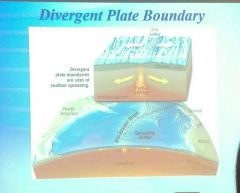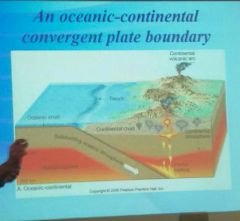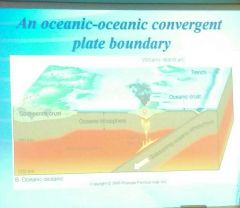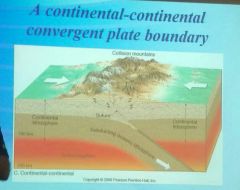![]()
![]()
![]()
Use LEFT and RIGHT arrow keys to navigate between flashcards;
Use UP and DOWN arrow keys to flip the card;
H to show hint;
A reads text to speech;
45 Cards in this Set
- Front
- Back
- 3rd side (hint)
|
Who was the first person to propose a hypothesis about the continental drift? |
Alfred Wegener *also published a book called "the origin of continents and oceans"*
|
|
|
|
What is the continental drift hypothesis? |
That our continents were all one super continent called Pangaea that began breaking apart about 200 million years ago, continents "broke" through the earth's crust and drifted to their present positions |
|
|
|
What was the evidence Wegener had to prove continental drift? |
-the way south America and Africa fit together -fossils that match across the seas -the rock types and structures match -ancient climates |
|
|
|
What was the main objection to continental drift? |
It's inability to provide a mechanism (why the plates were moving) |
|
|
|
What evidence did Wegener observe? |
He had evidence of a thick ice sheet in the southern continents and tropical conditions (e.g. coal/swamps) in North America |
|
|
|
What are the two main reasons why Wegener's hypothesis was not widely accepted? |
1) Wegener could not explain why or how the continents moved 2) critics came up with an alternative explanation |
|
|
|
What was the alternative explanation that critics came up with to explain away Wegener's hypothesis of continental drift? |
Land bridges allowed fossil organisms to move between continents |
|
|
|
In the decades following Wegener's research, what were the key observations made about the seafloor that contributed to a new understanding if the seafloor (and to the discovery of platectonics) |
-seafloor topography (shape) -the age of the seafloor -heat flow Volcanoes and earthquakes |
|
|
|
The ___________ occupies much of the seafloor in all the world's ocean basins and often found towards the center of the oceans |
Ocean ridge system |
|
|
|
________ are found adjacent to some continents or islands chains and along the margins of the ocean *most common around the pacific ocean* |
Ocean trenches |
|
|
|
Rocks on the seafloor are ________ than 200 million years old |
Younger |
|
|
|
Rocks on the continents are as old as _________ years old |
4 billion |
|
|
|
Younger rocks are found in the ocean on the _______ and the oldest are found on the ________ |
Seafloor, coasts |
|
|
|
Most of the active volcanoes are located around the ________ which are found near the oceanic trenches |
The pacific rim (ring of fire) |
|
|
|
_______ are found near the oceanic ridge and trenches |
Earthquakes |
|
|
|
Earthquake s recorded to a depth of ______ |
800 km |
|
|
|
Deep earthquakes are found only near _____________ |
Oceanic trenches |
|
|
|
____________ is the modern explanation replacing continental drift |
Plate tectonics |
|
|
|
The _________ exists between the lithosphere, is hotter and weaker than the lithosphere, and allows for the motion of the lithosphere |
Asthenisphere |
|
|
|
All major interactions among plates occur along their ________ |
Boundaries |
|
|
|
Ocean crust ->_________ |
Basalt (lava) 10% more dense and has heavier elements |
|
|
|
Continental crust ->__________ |
Granite and is lighter elements |
|
|
|
-happens when two plates move apart -mantle material up wells to create a new seafloor-oceanic ridges and seafloor spreading -->oceanic ridges develop along well developed boundaries--> along ridges, seafloor spreading creates a new seafloor -only really gets volcanoes here These are all characteristics of what type of plate boundary? Are the margins constructive or destructive or staying the same?Are they moving together or apart? |

Divergent plate boundary Constructive Pulling apart |
|
|
|
- plates collide an ocean trench forms and lithosphere is subjected into the mantle -volcanisms result from the subduction--> either in the form of volcanic mountains (on land) or volcanic islands (in the ocean) These are all characteristics of what type of plate boundary? Are the margins constructive or destructive or staying the same? |
Convergent boundaries Destructive margins |
|
|
|
-Dense oceanic slab sinks into the asthenosphere -pockets of magma develop and rise - continental volcanic arcs form -volcanoes, mountains, earthquakes happen here (and is the only one that all three happens here) These are characteristics of what type of plat boundaries? |

Oceanic-continental convergent boundaries
|
-oceanic is always subducted and can never be the continental because it is too light |
|
|
-often forms volcanoes on the oceanic floor -volcanic islands Arcs form as volcanoes emerge from the sea *volcanoes and earthquakes happen here* These are all characteristics of what type of plate boundary? |

An oceanic to oceanic convergent plate boundary |
-two oceanic slabs converge and one descends beneath the other |
|
|
-when subducting plates contain continental material - can produce new mountain ranges -mountains and earthquakes both happen here no volcanoes These are all characteristics of what type of plate boundary? |

Continental-continental boundary |
two continents collide (which means no subduction) |
|
|
What are some examples that prove oceanic-continental convergent boundaries has happened |
Andes, cascades, and the Sierra nevada systems |
|
|
|
What are some examples that prove oceanic-oceanic convergent boundaries has happened? |
Tonga islands, Japan, and the Philippians |
|
|
|
What are some examples that proves continental-continental convergent boundaries has happened |
Himalayas, Alps, and Appalachians mountains |
|
|
|
-Plates slide past one another -most join two segments of a mid ocean ridge -helps aid the movement of oceanic crustal movement Only earthquakes happen here! (No volcanoes or mountains!) These are all characteristics of what type of plate boundary? Are the margins constructive or destructive or staying the same?Are they moving together or apart? |

Transform fault boundary Stays the same Pulls apart |
|
|
|
What is an example of a transfer fault boundary? |
San Andreas fault in CA |
|
|
|
Mantle plumes are caused by rising plumes of mantal material called ________ |
; hot spot |
|
|
|
Volcanoes can form over hot spots two examples are __________ and ________ |
The Hawaiian island chains and Yellowstone national park |
|
|
|
Ages of these volcanoes ______ as you go Northwest of the big island of Hawaii |
Increase |
|
|
|
The Hawaiian Islands have formed over a _______ Hot spot |
Stationary |
|
|
|
What will be the next Hawaiian island? |
Loihi |
|
|
|
What happens where the plates move faster? |
More activity (volcanoes and earthquakes) |
|
|
|
Which of the three (volcanoes, earthquakes, mountains) happens in divergent plate boundaries? |
Only really gets Volcanoes (no earthquakes) |
|
|
|
Which of the three (volcanoes, earthquakes, mountains) happens in oceanic-continental convergent boundaries? |
Volcanoes, mountains, and earthquakes |
|
|
|
Which of the three (volcanoes, earthquakes, mountains) happens oceanic-oceanic convergent plate boundaries? |
Volcanoes and earthquakes |
|
|
|
Which of the three (volcanoes, earthquakes, mountains) happens in continental-continental convergent fault boundaries? |
Mountains and earthquakes |
|
|
|
Which of the three (volcanoes, earthquakes, mountains) happens in transform fault boundaries? |
Just earthquakes |
|
|
|
What is the larges plate? |
Pacific plate |
|
|
|
The collision of India and Asia produced what? |
The Himalayas |
|

